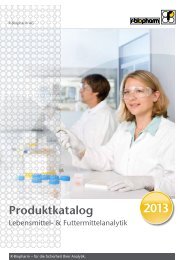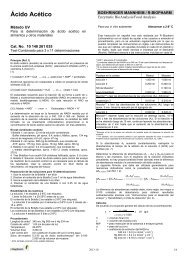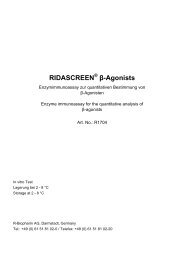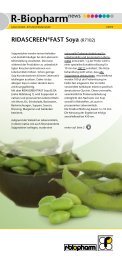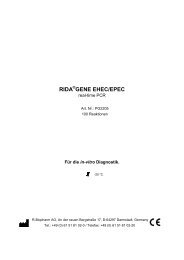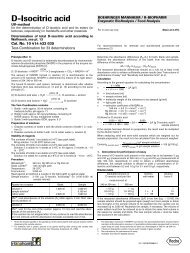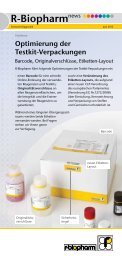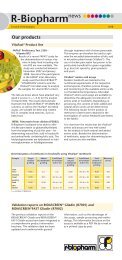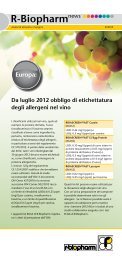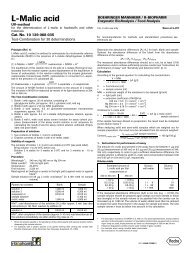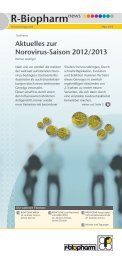Lactose/D-Galactose - R-Biopharm AG
Lactose/D-Galactose - R-Biopharm AG
Lactose/D-Galactose - R-Biopharm AG
Create successful ePaper yourself
Turn your PDF publications into a flip-book with our unique Google optimized e-Paper software.
<strong>Lactose</strong>/D-<strong>Galactose</strong><br />
UV-method<br />
for the determination of lactose and D-galactose in foodstuffs<br />
and other materials<br />
Cat. No. 10 176 303 035<br />
Test-Combination for 32 determinations<br />
BOEHRINGER MANNHEIM / R-BIOPHARM<br />
Enzymatic BioAnalysis / Food Analysis<br />
For in vitro use only<br />
Store at 2-8° C<br />
For recommendations for methods and standardized procedures see<br />
references (A 2, B 2)<br />
Principle (Ref. A1)<br />
<strong>Lactose</strong> is hydrolyzed to D-glucose and D-galactose at pH 6.6 in the<br />
presence of the enzyme -galactosidase and water (1).<br />
(1) <strong>Lactose</strong> + H 2 O -galactosidase D-glucose + D-galactose<br />
D-<strong>Galactose</strong> is oxidized at pH 8.6 by nicotinamide-adenine dinucleotide<br />
(NAD) to D-galactonic acid in the presence of the enzyme -galactose<br />
dehydrogenase (Gal-DH) (2).<br />
(2) D-galactose + NAD + Gal-DH D-galactonic acid + NADH + H + solution 3<br />
1.000 ml 1.000 ml 1.000 ml 1.000 ml<br />
The amount of NADH formed in reaction (2) is stoichiometric to the amount redist. water 2.000 ml 1.900 ml 2.050 ml 1.950 ml<br />
of lactose, and D-galactose, resp. The increase in NADH is measured by<br />
Mix***, after approx. 2 min read absorbances of the solutions (A<br />
means of its light absorbance at 334, 340 or 365 nm.<br />
1 ). Start reaction<br />
by addition of:<br />
The Test-Combination contains<br />
suspension 4 0.050 ml 0.050 ml 0.050 ml 0.050 ml<br />
1. Bottle 1 with approx. 600 mg lyophilizate, consisting of:<br />
citrate buffer, pH approx. 6.6; NAD, approx. 35 mg; magnesium sulfate Mix***, wait until reaction has stopped (approx. 15 min with 50 g lactose/<br />
2. Bottle 2 with approx. 1.7 ml -galactosidase suspension, approx. 100 U assay and approx. 30 min with 200 g lactose/assay) and read absorbances<br />
3. Bottle 3 with approx. 34 ml solution, consisting of:<br />
of the solutions (A 2 ).<br />
potassium diphosphate buffer, pH approx. 8.6<br />
If the reaction has not stopped after 15 min, continue to read the absorbances<br />
at 5 min intervals until the absorbance increases constantly over<br />
4. Bottle 4 with approx. 1.7 ml galactose dehydrogenase suspension,<br />
approx. 40 U<br />
5min.<br />
5. Bottle 5 with lactose assay control solution for assay control purposes<br />
(measurement of the assay control solution is not necessary for calculating<br />
the results.) Use the assay control solution undiluted. (Expiry date:<br />
* Pipette solution 1, suspension 2 and sample solution, each onto the bottom of the cuvette,<br />
mix by swirling. When using a plastic spatula, remove it from the cuvette only directly before<br />
measuring absorbance A<br />
see pack label)<br />
1 .<br />
** Rinse the enzyme pipette or the pipette tip of the piston pipette with sample solution before<br />
Preparation of solutions<br />
dispensing the sample solution.<br />
*** For example, with a plastic spatula or by gentle swirling after closing the cuvette with<br />
1. Dissolve contents of bottle 1 with 7.0 ml redist. water.<br />
Parafilm (trademark of the American Can Company, Greenwich, Ct., USA)<br />
2. Use suspension of bottle 2 undiluted.<br />
3. Use solution of bottle 3 undiluted.<br />
4. Use suspension of bottle 4 undiluted.<br />
Stability of reagents<br />
The contents of bottle 1 are stable at 2-8°C (see pack label).<br />
Solution 1 is stable for 3 months at 2-8°C.<br />
Bring solution 1 to 20-25°C before use.<br />
The contents of bottles 2, 3 and 4 are stable at 2-8°C (see pack label).<br />
Bring solution 3 to 20-25°C before use.<br />
Procedure<br />
Wavelength 1 : 340 nm, Hg 365 nm or Hg 334 nm<br />
Glass cuvette 2 : 1.00 cm light path<br />
Temperature: 20-25°C<br />
Final volume: 3.300 ml<br />
Read against air (without a cuvette in the light path) or against water<br />
Sample solution: 4-200 μg lactose and D-galactose/assay 3<br />
in 0.100-0.500 ml sample volume<br />
1 The absorption maximum of NADH is at 340 nm. On spectrophotometers, measurements<br />
are taken at the absorption maximum; if spectralline photometers equipped with a mercury<br />
vapor lamp are used, measurements are taken at a wavelength of 365 nm or 334 nm.<br />
2 If desired, disposable cuvettes may be used instead of glass cuvettes.<br />
3 See instructions for performance of assay<br />
4 The performance of blank D-galactose sample and D-galactose sample can be omitted if<br />
the sample does not contain free D-galactose.<br />
Pipette into<br />
cuvettes<br />
solution 1*<br />
suspension 2<br />
sample solution**<br />
Blank<br />
lactose sample<br />
0.200 ml<br />
0.050 ml<br />
-<br />
<strong>Lactose</strong><br />
sample<br />
0.200 ml<br />
0.050 ml<br />
0.100 ml<br />
Blank 4<br />
D-galactose<br />
sample<br />
0.200 ml<br />
-<br />
-<br />
Mix* and incubate for minimum 20 min at 20-25°C. Add:<br />
D-<strong>Galactose</strong><br />
sample 4<br />
0.200 ml<br />
-<br />
0.100 ml<br />
If the absorbance A 2 increases constantly, extrapolate the absorbance to the<br />
time of the addition of suspension 4 (ß-galactose dehydrogenase).<br />
Determine the absorbance differences (A 2 -A 1 ) for both, blanks and samples.<br />
Subtract the absorbance difference of the blank from the absorbance difference<br />
of the corresponding sample.<br />
A = (A 2 -A 1 ) sample - (A 2 -A 1 ) blank<br />
It follows A D-galactose (from “D-galactose sample”) and<br />
A lactose + D-galactose (from “lactose sample”)<br />
The difference of these values stands for A lactose .<br />
The measured absorbance differences should, as a rule, be at least 0.100<br />
absorbance units to achieve sufficiently precise results (see “Instructions for<br />
performance of assay“ and “Sensitivity and detection limit”, pt. 4).<br />
Calculation<br />
According to the general equation for calculating the concentrations:<br />
c = V × MW × A [g/l]<br />
ε × d × v × 1000<br />
V = final volume [ml]<br />
v = sample volume [ml]<br />
MW = molecular weight of the substance to be assayed [g/mol]<br />
d = light path [cm]<br />
ε = extinction coefficient of NADH at:<br />
340 nm = 6.3 [l × mmol -1 × cm -1 ]<br />
Hg 365 nm = 3.4 [l × mmol -1 × cm -1 ]<br />
Hg 334 nm = 6.18 [l × mmol -1 × cm -1 ]<br />
It follows for lactose (calculated as anhydrous lactose):<br />
3.300 × 342.3<br />
c =<br />
× A lactose = 11.30 × A lactose [g lactose/l<br />
ε × 1.00 × 0.100 × 1000<br />
ε sample solution]<br />
0214.10249106001➄
for lactose (calculated as lactose monohydrate):<br />
3.300 × 360.32<br />
c =<br />
× A lactose = 11.89 × A lactose [g lactose ×<br />
ε × 1.00 × 0.100 × 1000<br />
ε H 2 O/l sample<br />
solution]<br />
for D-galactose:<br />
3.300 × 180.16<br />
c =<br />
× A galactose = 5.945 × A D-galactose [g D-<br />
ε × 1.00 × 0.100 × 1000<br />
ε galactose/l sample<br />
solution]<br />
If the sample has been diluted during preparation, the result must be<br />
multiplied by the dilution factor F.<br />
When analyzing solid and semi-solid samples which are weighed out for<br />
sample preparation, the result is to be calculated from the amount weighed:<br />
c lactose [g/l sample solution]<br />
Content lactose =<br />
weight<br />
× 100 [g/100 g]<br />
sample in g/l sample solution<br />
c D-galactose [g/l sample solution]<br />
Content D-galactose =<br />
weight<br />
× 100 [g/100 g]<br />
sample in g/l sample solution<br />
1. Instructions for performance of assay<br />
The amount of lactose and D-galactose present in the assay has to be<br />
between 10 g and 200 g (measurement at 365 nm) or 4 g and 100 g<br />
(measurement at 340, 334 nm), respectively. In order to get a sufficient<br />
absorbance difference, the sample solution is diluted to yield a lactose and<br />
D-galactose concentration between 0.3 and 2 g/l or 0.2 and 1 g/l, respectively.<br />
Dilution table<br />
Estimated amount of<br />
lactose and D-galactose per liter<br />
measurement at<br />
340 or 334 nm 365 nm<br />
1.0 g<br />
1.0-10.0 g<br />
10.0-100 g<br />
100 g<br />
2.0 g<br />
2.0-20.0 g<br />
20.0-200 g<br />
200 g<br />
Dilution<br />
with water<br />
-<br />
1 + 9<br />
1 + 99<br />
1 + 999<br />
Dilution<br />
factor F<br />
1<br />
10<br />
100<br />
1000<br />
If the measured absorbance difference (A) is too low (e.g. 0.100), the<br />
sample solution should be prepared again (weigh out more sample or dilute<br />
less strongly) or the sample volume to be pipetted into the cuvette can be<br />
increased up to 0.500 ml (neutralize sample previously, if necessary). The<br />
volume of water added must then be reduced so as to obtain the same final<br />
volume in the assays for sample and blank. The new sample volume v must<br />
be taken into account in the calculation.<br />
2. Technical information<br />
2.1 Many foodstuffs do not contain free D-galactose. The determination of<br />
D-galactose can therefore be omitted.<br />
2.2 If only D-galactose is to be determined (or L-arabinose, see pt. 11), the<br />
assay procedure may be continued without incubation after addition of<br />
the sample solution.<br />
2.3 The calculation of the results can be done on the basis of anhydrous<br />
lactose (molecular weight 342.3), which can be recommended, and on<br />
the basis of lactose monohydrate (molecular weight 360.32). When<br />
comparing data, one has to make sure that the same molecular weight<br />
has been used for the calculation (figures for lactose monohydrate are<br />
5% higher than those for anhydrous lactose).<br />
3. Specificity<br />
β-Galactosidase hydrolyzes -galactosidic bonds e.g. in lactose and with<br />
reduced speed in lactulose with the uptake of water.<br />
Apart from D-galactose, Gal-DH also oxidizes L-arabinose. Small amounts of<br />
free D-galactose and L-arabinose only occur in foodstuffs, if they have been<br />
released from their natural glycosidic linkage (e.g. of swelling materials) due<br />
to chemical or enzymatic influences.<br />
In the analysis of commercial lactose monohydrate (molecular weight<br />
360.32) and of D-galactose (molecular weight 180.16) results of 100%<br />
have to be expected because the materials absorb moisture.<br />
4. Sensitivity and detection limit<br />
The smallest differentiating absorbance for the procedure is 0.005<br />
absorbance units. This corresponds to a maximum sample volume v =<br />
0.500 ml and measurement at 340 nm of a lactose concentration of 2 mg/l,<br />
resp. 1 mg D-galactose/l sample solution (if v = 0.100 ml, this corresponds<br />
to 10 mg lactose/l, resp. 5 mg D-galactose/l sample solution).<br />
The detection limit of 7 mg lactose/l, resp. 4 mg D-galactose/l is derived<br />
from the absorbance difference of 0.020 (as measured at 340 nm) and a<br />
maximum sample volume v = 0.500 ml.<br />
5. Linearity<br />
Linearity of the determination exists from approx. 4 g lactose + D-galactose/<br />
assay (7 mg lactose + D-galactose/l sample solution; sample volume v =<br />
0.500 ml) to 200 g lactose + D-galactose/assay (2 g lactose + D-galactose/l<br />
sample solution; sample volume v = 0.100ml).<br />
6. Precision<br />
In a double determination of D-galactose using one sample solution, a<br />
difference of 0.005 to 0.010 absorbance units may occur. With a sample<br />
volume of v = 0.100 ml and measurement at 340 nm, this corresponds to a<br />
D-galactose concentration of approx. 5-10 mg/l. (If the sample is diluted<br />
during sample preparation, the result has to be multiplied by the dilution<br />
factor F. If the sample is weighed in for sample preparation, e.g. using 1 g<br />
sample/ 100 ml = 10 g/l, a difference of 0.05-0.1 g/100 g can be expected.)<br />
In a double determination of lactose using one sample solution, a difference<br />
of 0.010 to 0.015 absorbance units may occur in the presence of D-galactose<br />
in the sample. With a sample volume of v = 0.100 ml and measurement<br />
at 340 nm, this corresponds to a lactose concentration of approx. 15-25 mg/<br />
l. (If the sample is diluted during sample preparation, the result has to be<br />
multiplied by the dilution factor F. If the sample is weighed in for sample<br />
preparation, e.g. using 1 g sample/100 ml = 10 g/l, a difference of 0.15-<br />
0.25 g/100 g can be expected.)<br />
The following data for the determination of lactose and D-galactose have<br />
been published in the literature:<br />
<strong>Lactose</strong> in chocolate:<br />
x = 6.01 g/100 g s = 0.04 g/100 gCV = 0.7 % (Ref. A 1.1)<br />
25 g D-galactose/assay CV = 0.95 %<br />
85 g lactose/assay CV = 1.13 %<br />
50 g D-galactose/assay CV = 0.64 %<br />
170 g lactose/assay CV = 0.78 % (Ref. A 1.2)<br />
Milk and milk products:<br />
<strong>Lactose</strong>: r = 0.05 × (content lactose in g/100 g) g/100 g<br />
R = 0.06 × (content lactose in g/100 g) g/100 g<br />
D-<strong>Galactose</strong>: r = 0.10 × (content d-<strong>Galactose</strong> in g/100 g) g/100 g<br />
R = 0.12 × (content d-<strong>Galactose</strong> in g/100 g) g/100 g<br />
<strong>Lactose</strong> in chocolate: r = 0.188 g/100 g s (r) = ± 0.066 g/100 g<br />
R = 0.434 g/100 g s (R) = ± 0.153 g/100 g<br />
(Ref. A 2.5)<br />
For further data see references.<br />
7. Recognizing interference during the assay procedure<br />
7.1 If the conversion of D-galactose has been completed according to the<br />
time given under “Procedure“, it can be concluded in general that no<br />
interference has occurred.<br />
7.2 On completion of the reaction, the determination can be restarted by<br />
adding D-galactose (qualitative or quantitative): if the absorbance is<br />
altered subsequent to the addition of the standard material, this is also<br />
an indication that no interference has occurred.<br />
The reaction cannot be restarted with lactose as, subsequent to altering<br />
the reaction conditions from pH 6.6 to pH 8.6 (“change of the buffer“),<br />
lactose is no longer cleaved.<br />
7.3 Operator error or interference of the determination through the presence<br />
of substances contained in the sample can be recognized by carrying<br />
out a double determination using two different sample volumes (e.g.<br />
0.100 ml and 0.200 ml): the measured differences in absorbance should<br />
be proportional to the sample volumes used.<br />
When analyzing solid samples, it is recommended that different quantities<br />
(e.g. 1 g and 2 g) be weighed into 100 ml volumetric flasks. The<br />
absorbance differences measured and the weights of sample used<br />
should be proportional for identical sample volumes.<br />
The use of “single“ and “double“ sample volumes in double determinations<br />
is the simplest method of carrying out a control assay in the determination<br />
of lactose.<br />
7.4 Possible interference caused by substances contained in the sample can<br />
be recognized by using an internal standard as a control: in addition to<br />
the sample, blank and standard determinations, a further determination<br />
should be carried out with sample and assay control solution in the<br />
same assay. The recovery can then be calculated from the absorbance<br />
differences measured.<br />
2
7.5 Possible losses during the determination can be recognized by carrying<br />
out recovery tests: the sample should be prepared and analyzed with<br />
and without added standard material. The additive should be recovered<br />
quantitatively within the error range of the method.<br />
8. Reagent hazard<br />
The reagents used in the determination of lactose and D-galactose are not<br />
hazardous materials in the sense of the Hazardous Substances Regulations,<br />
the Chemicals Law or EC Regulation 67/548/EEC and subsequent alteration,<br />
supplementation and adaptation guidelines. However, the general safety<br />
measures that apply to all chemical substances should be adhered to.<br />
After use, the reagents can be disposed of with laboratory waste, but local<br />
regulations must always be observed. Packaging material can be disposed<br />
of in waste destined for recycling.<br />
9. General information on sample preparation<br />
In carrying out the assay:<br />
Use clear, colorless and practically neutral liquid samples directly, or<br />
after dilution according to the dilution table, and of a volume up to 0.500 ml;<br />
Filter turbid solutions;<br />
Degas samples containing carbon dioxide (e.g. by filtration);<br />
Treat “strongly colored“ samples that are used undiluted or with a higher<br />
sample volume with polyvinylpolypyrrolidone (PVPP) or with polyamide, e.g.<br />
1 g/100 ml;<br />
Crush or homogenize solid or semi-solid samples, extract with hot water<br />
or dissolve in water and filter if necessary; resp. remove turbidities or<br />
dyestuffs by Carrez clarification;<br />
Deproteinize samples containing protein with perchloric acid or with trichloroacetic<br />
acid; alternatively clarify with Carrez reagents;<br />
Extract samples containing fat with hot water (extraction temperature<br />
should be above the melting point of the fat involved). Cool to allow the fat<br />
to separate, make up to the mark, place the volumetric flask in an ice bath<br />
for 15 min and filter; alternatively clarify with Carrez-solutions after the<br />
extraction with hot water;<br />
Break emulsions with trichloroacetic acid or clarify with Carrez-solutions.<br />
Carrez clarification:<br />
Pipette the liquid sample into a 100 ml volumetric flask which contains<br />
approx. 60 ml redist. water, or weigh sufficient quantity of the sample into a<br />
100 ml volumetric flask and add approx. 60 ml redist. water. Subsequently,<br />
carefully add 5 ml Carrez-I-solution (potassium hexacyanoferrate(II) (ferrocyanide),<br />
85 mM = 3.60 g K 4 [Fe(CN) 6 ] × 3 H 2 O/100 ml) and 5 ml Carrez-IIsolution<br />
(zinc sulfate, 250 mM = 7.20 g ZnSO 4 × 7 H 2 O/100 ml). Adjust to pH<br />
7.5-8.5 with sodium hydroxide (0.1 M; e.g. 10 ml). Mix after each addition. Fill<br />
the volumetric flask to the mark, mix and filter.<br />
10. Application examples<br />
Determination of lactose in drinking milk, condensed milk and sour<br />
milk<br />
Accurately weigh approx. 2 g of milk into a 100 ml volumetric flask. Dilute<br />
with approx. 20 ml water and add 1.0 ml trichloroacetic acid (3 M) for protein<br />
precipitation. After 10 min incubation neutralize with NaOH (1 M), fill up to<br />
100 ml with water, filter and use the clear, possibly slightly opalescent solution<br />
for the assay.<br />
In the case of sour milk, there is no need for deproteinization.<br />
When lactose is determined in drinking milk or condensed milk, clarification<br />
can also be carried out with Carrez reagents (see “determination of lactose<br />
in yogurt“). Amount weighed: approx. 2 g.<br />
Determination of lactose in hard cheese or chocolate<br />
Grate cheese crumbs or chocolate, accurately weigh approx. 2 g into a<br />
100 ml volumetric flask, add approx. 70 ml water and incubate for 15 min at<br />
approx. 70°C. Shake from time to time. After cooling to 20-25°C, fill up to the<br />
mark with water and mix. To separate the fat, place in a refrigerator for<br />
approx. 20 min and filter. Discard the first few ml. Use the clear, possibly<br />
slightly opalescent solution for the assay.<br />
Determination of lactose in processed cheese<br />
Accurately weigh approx. 3 g of homogeneous sample into a 100 ml volumetric<br />
flask, add approx. 70 ml water and incubate for 15 min at approx.<br />
70°C while continuously stirring (magnetic stirrer). After cooling to 20-25°C,<br />
add 2 ml trichloroacetic acid (3 M) and mix. Neutralize with approx. 6 ml<br />
NaOH (1 M), fill up to the mark with water.<br />
For the separation of fat, place in a refrigerator for approx. 20 min, filter or<br />
centrifuge. Use the clear, possibly slightly opalescent solution for the assay.<br />
Alternatively the procedure “determination of lactose in yogurt“ can also be<br />
used. Amount weighed: approx. 3 g.<br />
Determination of lactose in instant baby food, restorative food or ice<br />
cream<br />
Accurately weigh approx. 1 g of sample into a 100 ml volumetric flask, add<br />
approx. 60 ml water and incubate for 15 min at approx. 70°C, shake from<br />
time to time. After cooling to 20-25°C, add 10 ml perchloric acid (3 M) and<br />
mix. After 10 min neutralize with KOH (3 M) to pH 7, fill up to the mark with<br />
water and place in a refrigerator for 20 min to precipitate the KCIO 4 formed,<br />
filter. Use the clear, possibly slightly turbid solution for the assay, diluted, if<br />
necessary.<br />
Determination of lactose in yogurt, cream powder, milk powder and<br />
whey powder<br />
Accurately weigh approx. 1 g of sample into a 100 ml volumetric flask, add<br />
approx. 60 ml water and incubate for 15 min at approx. 70°C; shake from<br />
time to time. For clarification, add 5 ml of Carrez-I-solution (3.60 g potassium<br />
hexacyanoferrate(II), K 4 [Fe(CN) 6 ] × 3 H 2 O/100 ml), 5 ml of Carrez-II-solution<br />
(7.20 g of zinc sulfate, ZnSO 4 × 7 H 2 O/100 ml) and 10 ml of NaOH<br />
(0.1 M); mix after each addition, adjust to 20-25°C and fill up to the mark<br />
with water, filter. Use the clear, possibly slightly turbid solution for the assay,<br />
diluted, if necessary.<br />
Determination of lactose in meat sausage and meat loaf<br />
Accurately weigh approx. 5 g of cut or grated sample (mixer) into a 100 ml<br />
volumetric flask, add about 70 ml water and incubate for 15 min at approx.<br />
70°C. Allow to cool to 20-25°C and fill up to the mark with water. For the<br />
separation of fat, place in a refrigerator for 20 min and filter. Use the clear,<br />
possibly slightly turbid solution for the assay.<br />
Determination of lactose in samples containing protein<br />
Add perchloric acid (1 M) to protein-containing sample solutions in a ratio<br />
of 1:3 (1+2), mix, centrifuge, and neutralize an aliquot portion of the supernatant<br />
solution with KOH (2 M). Fill up to a certain volume in the volumetric<br />
flask, place in a refrigerator for 20 min to precipitate the KCIO 4 and filter.<br />
Use the clear solution for the assay, diluted, if necessary.<br />
11. Determination of L-arabinose<br />
In the absence of D-galactose, the Gal-DH reaction can be used to determine<br />
L-arabinose. Then the reaction time rises to 30 min (after addition of<br />
suspension 4).<br />
12. Further applications<br />
The method may also be used in the examination of pharmaceuticals (Ref. A<br />
4.1) and in research when analyzing biological samples. For details of<br />
sampling, treatment and stability of the sample see Ref. A 1.1.<br />
12.1. Determination of lactose in the urine of cows (Ref. A 4.2)<br />
Dilute urine according to the dilution table and use it for the assay (dilution<br />
factor = F)<br />
Important note: Incubate the mixture of solution 1, suspension 2 and the<br />
sample solution at 20-25°C for 30 min.<br />
Calculation:<br />
11.30 × A × F<br />
c =<br />
[g lactose/l sample]<br />
ε<br />
c =<br />
33.00 × A × F [mmol lactose/l sample]<br />
ε<br />
Wavelength Hg 365 nm 340 nm Hg 334 nm<br />
c [g/l] 3.324 × A × F 1.794 × A × F 1.828 × A × F<br />
c [mM] 9.706 × A × F 5.238 × A × F 5.340 × A × F<br />
12.2 Determination of lactose in fermentation samples and cell<br />
culture media<br />
Place the sample (after centrifugation, if necessary) in a water-bath at 80°C<br />
for 15 min to stop enzymatic reactions. Centrifuge and use the supernatant<br />
(diluted according to the dilution table, if necessary) for the assay. Alternatively,<br />
deproteinization can be carried out with perchloric acid or with<br />
Carrez-solutions. See the above-mentioned examples.<br />
Homogenize gelatinous agar media with water and treat further as<br />
described.<br />
A. References for the determination of lactose and D-galactose<br />
A 1.1 Kurz, G. & Wallenfels, K. (1974) in Methoden der enzymatischen Analyse, (Bergmeyer,<br />
H.U., Hrsg.) 3. Aufl., Bd. 2, S. 1225-1229 and S. 1324-1327, Verlag Chemie, Weinheim,<br />
and (1974) in Methods of Enzymatic Analysis (Bergmeyer, H.U., ed.) 2nd ed., vol. 3, pp.<br />
1180-1184 and pp. 1279-1282, Verlag Chemie, Weinheim/Academic Press, Inc. New<br />
York and London<br />
A 1.2 Beutler, H. O. (1984) in Methods of Enzymatic Analysis (Bergmeyer, H. U., ed.) 3rd ed.,<br />
vol. VI, pp. 104-112, Verlag Chemie, Weinheim, Deerfield Beach/Florida, Basel<br />
3
A 2.1 Schweizerisches Lebensmittelbuch, Kapitel 61B (Enzymatische Bestimmungen)/1.4.<br />
(1981), Kapitel 1 (Milch)/1.11.2 (1995), Kapitel 2B (Sauermilchprodukte)/09 (1980),<br />
Kapitel 4 (Milchdauerwaren)/5.1 (1993), Kapitel 9 (Speiseeis)/4.3 (1983), Kapitel 22<br />
(Diätetische Lebensmittel und Speziallebensmittel)/6.3 (1991), Kapitel 28A (Frucht- und<br />
Gemüsesäfte u.a.)/5.4 (1988), Kapitel 34 (Gärungsessig)/8.2 (1994)<br />
A 2.2 Gombocz, E., Hellwig, E., Vojir, F. & Petuely, F. (1981) Deutsche Lebensmittel-Rundschau<br />
77, 3-4 (<strong>Galactose</strong>) und 10 (<strong>Lactose</strong>)<br />
A 2.3 Norme Belge - Belgische Norm NBN V 21-023 (1e éd., juin 1981) Lait et Produits<br />
Laitiers: Determination Enzymatique du <strong>Lactose</strong>, Melk en Zuivelprodukten,<br />
Enzymatische Bepaling van <strong>Lactose</strong>, Milch und Milchprodukte, Enzymatische<br />
Bestimmung von <strong>Lactose</strong><br />
A 2.4 Deutsche Norm DIN 10344 (August 1982) Bestimmung des <strong>Lactose</strong>- und <strong>Galactose</strong>gehalts<br />
von Milch und Milchprodukten<br />
A 2.5 Amtliche Sammlung von Untersuchungsverfahren nach § 64. LFGB; Untersuchung von<br />
Lebensmitteln: Bestimmung von <strong>Lactose</strong> in Fleischerzeugnissen (07.00-23/ Mai 1983);<br />
Bestimmung von <strong>Lactose</strong> in Wurstwaren (08.00-24/Mai 1983); Bestimmung des<br />
<strong>Lactose</strong>- und <strong>Galactose</strong>gehalts von Milch und Milchprodukten (01.00-17/September<br />
2010); Bestimmung des <strong>Lactose</strong>- und <strong>Galactose</strong>gehalts von Milchprodukten (02.00-9/<br />
September 2010); Bestimmung von <strong>Lactose</strong> in Brot einschließlich Kleingebäck aus<br />
Brotteigen (17.00-7/November 1983); Bestimmung von <strong>Lactose</strong> in feinen Backwaren<br />
(18.00-8/November 1984); Bestimmung von <strong>Lactose</strong> in teiladaptierter Säuglingsnahrung<br />
auf Milchbasis (48.01-4/Mai 1985); Bestimmung von <strong>Lactose</strong> in Kinder-Zwieback<br />
und Zwiebackmehl (48.02.07-4/Mai 1985); Bestimmung von <strong>Lactose</strong> in Schokolade<br />
(44.00-6/Dezember 1985)<br />
A 2.6 Österreichisches Lebensmittelbuch (Codex Alimentarius Austriacus), Kapitel B15<br />
(Kakao, Kakaoerzeugnisse, Lebensmittel mit Kakao oder Schokolade, Nougat, Nougatmassen)<br />
(1983); Kapitel B22 (Zucker und Zuckerarten) (1983)<br />
A 2.7 OFFICIAL METHODS OF ANALYSIS of the Association of Official Analytical Chemists<br />
(Williams, S., ed.) 14th edition (1984), p. 284; 15th edition (1990), vol. 2, pp. 810-811<br />
(984.15)<br />
A 2.8 Verband Deutscher Landwirtschaftlicher Untersuchungs- und Forschungsanstalten,<br />
VDLUFA (Januar 1985) Methodenbuch Band VI, C 20.2.3 (VDLUFA-Verlag Darmstadt)<br />
A 2.9 Niederlande: Warenwet, Uitvoeringsvoorschriften (C II-6) Regeling Onderzoekingsmethoden<br />
voor brood; Methode 18: De Bepaling van het <strong>Lactose</strong>gehalte (Oktober<br />
1986); Dit voorschrift betrijft een methode voor de bepaling van het watervrije lactosegehalte<br />
in brood<br />
A 2.10 International Dairy Federation, International IDF Standard 79B:1991: Dried Milk, Dried<br />
Ice-Mixes & Processed Cheese, Determination of <strong>Lactose</strong> Content, Enzymatic Methods<br />
A 2.11 Standard der Russischen Föderation / Standard of the Russian Federation / GOSSTAN-<br />
DART ROSSII GOST R 51259-99 (1999) Milk and milk products. Method for determination<br />
of lactose and galactose content<br />
A 2.12 Draft International Standard ISO/DIS 5765-2 (1998) Dried milk, dried ice-mixes and<br />
processed cheese - determination of lactose content - Part 2: Enzymatic method utilizing<br />
the galactose moiety of the lactose<br />
A 2.13 Bulletin of the IDF 285 (1993) Chapter 13, pp. 95 - 105, Milk and milk products - Determination<br />
of lactose content - Enzymatic methods<br />
A 3.1 Essig, A. M. & Kleyn, D. H. (1983) Determination of lactose in milk: comparison of<br />
methods, J. Assoc. Off. Anal. Chem. 66, 1514-1516<br />
A 3.2 Kleyn, D. H., & Trout, J. R. (1984) Enzymatic-ultraviolet method for measuring lactose in<br />
milk: collaborative study, J. Assoc. Off. Anal. Chem. 67, 637-640<br />
A 3.3 Kleyn, D.H. (1985) Symposium: Role and Significance of Enzymes in Dairy Processing;<br />
Determination of <strong>Lactose</strong> by an Enzymatic Method, J. Dairy Sci 68, 2791-2798<br />
A 3.4 Berner, G. (1970) Zuckerabbau während der Camembert-Reifung. Enzymatische<br />
Bestimmung von <strong>Lactose</strong>, D-Glucose und D-<strong>Galactose</strong>, Milchwissenschaft 25, 275-280<br />
A 3.5 Steffen, Chr., Nick, B. & Blanc, B. (1975) Methodik zur enzymatischen Bestimmung von<br />
<strong>Lactose</strong>, Glucose, <strong>Galactose</strong> und Lactat in Käse. Schweiz. Milchw. Forsch. 4, 13-15<br />
A 3.6 Salzer, U.-J. (1970) <strong>Lactose</strong>-Bestimmung in Fleischwaren, Die Fleischwirtschaft 50,<br />
1229-1232<br />
A 3.7 Bauer, F. & Stachelberger, H. (1984) Ein Schnellnachweis galaktosehaltiger<br />
Verdickungsmittel in Fleischwaren als Screening-Methode, Chem. Mikrobiol. Technol.<br />
Lebensm. 8, 129-132<br />
A 3.8 Mustranta, A. & Östman, C. (1997) Enzymatic Determination of <strong>Lactose</strong> and <strong>Galactose</strong><br />
in Foods: NMKL Collaborative Methods Performance Study, J.AOAC Intern. 80, 584-<br />
590<br />
A 3.9 Saalfeld, U. & Freund, W. (1999) Charakterisierung pulverisierter Sauerteige und Möglichkeiten<br />
ihrer qualitativen Bestimmung im Brot - Teil II: Untersuchung der Acetat-,<br />
<strong>Lactose</strong>-, Hexanal-, Calcium-, Kalium- und Natriumgehalte und der Thiobarbitursäurereaktiven<br />
Substanzen, Deutsche Lebensmittel-Rundschau 95, 297-304<br />
A 4.1 Henniger, G. & Hoch, H. (1981) Enzymatische Substrat-Bestimmungen in der<br />
pharmazeutischen Analytik, dargestellt an den Bestimmungen von L-Ascorbinsäure,<br />
Ethanol und <strong>Lactose</strong>, Deutsche Apotheker Zeitung 121, 643-649<br />
A 4.2 Saidon Sissoko (1983) Der <strong>Lactose</strong>-Gehalt in Harn und Milch des Rindes bei subklinischer<br />
B-Streptokokken-Mastitis. Dissertation. Tierärztliche Hochschule Hannover<br />
B. References for the determination of lactose and D-glucose<br />
B 1.1 Bahl, R. K. (1971) An enzymatic method for the determination of skimmed milk powder<br />
in raw sausages, Analyst 96, 88-92<br />
B 1.2 Bahl, R. K. (1972) An enzymatic method for the determination of lactose in milk<br />
including human milk, Analyst 97, 559-561<br />
B 1.3 Bergmeyer, H.U., Bernt, E., Schmidt, F. & Stork, H. (1974) in Methoden der<br />
enzymatischen Analyse (Bergmeyer, H.U., Hrsg.) 3. Aufl., Bd. 2, 1241-1246; Verlag<br />
Chemie, Weinheim, and (1974) in Methods of Enzymatic Analysis (Bergmeyer, H. U., ed.)<br />
2nd ed., vol. 3, pp. 1196-1201; Verlag Chemie, Weinheim/Academic Press, Inc., New<br />
York and London<br />
B 1.4 Kunst, A., Draeger, B. & Ziegenhorn, J. (1984) in Methods of Enzymatic Analysis (Bergmeyer,<br />
H.U., Hrsg.) 3rd ed., vol. VI, pp. 163-172, Verlag Chemie, Weinheim, Deerfield<br />
Beach/Florida, Basel<br />
B 2.1 International Dairy Federation, IDF, International Standard 79:1977, Milk and milk<br />
products - Determination of lactose in the presence of other reducing substances<br />
B 2.2 Milch und Milchprodukte - Bestimmung von <strong>Lactose</strong> in Gegenwart anderer reduzierender<br />
Substanzen, Internationaler Standard 79:1977, Milchwissenschaft 33, 749-751 (1978)<br />
B 2.3 Schweizerisches Lebensmittelbuch, Kapitel 61B (Enzymatische Bestimmungen)/1.5<br />
(1981), Kapitel 1 (Milch)/11.2 (1987), Kapitel 2A (Milchmischgetränke)/09 (1980),<br />
Kapitel 9 (Speiseeis)/4.3 (1983)<br />
B 2.4 Nederlandse Norm NEN 3769 (Dezember 1981) Kaas: Fysische en chemische methoden<br />
van onderzoek: Enzymatische bepaling van het lactosegehalte, (Cheese - Physical<br />
and chemical test methods - Enzymatic determination of the lactose content)<br />
B 2.5 International Dairy Federation, International IDF Standard 79B:1991: Dried Milk, Dried<br />
Ice-Mixes & Processed Cheese, Determination of <strong>Lactose</strong> Content, Enzymatic Methods<br />
B 2.6 Draft International Standard ISO/DIS 5765-1 (1998) Dried milk, dried ice-mixes and<br />
processed cheese - determination of lactose content - Part 1: Enzymatic method utilizing<br />
the glucose moiety of the lactose<br />
B 2.7 Bulletin of the IDF 285, Chapter 13, pp. 95 - 105, Milk and milk products - Determination<br />
of lactose content - Enzymatic methods<br />
<strong>Lactose</strong> assay control solution (Bottle 5)<br />
Concentration*: see bottle label<br />
<strong>Lactose</strong> assay control solution is a stabilized aqueous solution of lactose.<br />
It serves as an assay control solution for the enzymatic determination of lactose<br />
in foodstuffs and other materials.<br />
Application:<br />
1. Addition of lactose assay control solution to the assay mixture:<br />
Instead of the sample solution the assay control solution is used for the<br />
assay.<br />
2. Restart of the reaction, quantitatively:<br />
A restart of the reaction with assay control solution after completion of the<br />
reaction cannot be performed as under the assay conditions (potassium<br />
diphosphate buffer, pH 8.6) lactose is not cleaved. If necessary, restart with<br />
0.050 ml of a D-galactose solution (0.5 g/l)<br />
3. Internal standard:<br />
The assay control solution can be used as an internal standard in order to<br />
check the determination for correct performance (gross errors) and to see<br />
whether the sample solution is free from interfering substances:<br />
Pipette into<br />
cuvettes<br />
solution 1<br />
suspension 2<br />
sample solution<br />
assay control sln.<br />
Blank<br />
lactose sample<br />
0.200 ml<br />
0.050 ml<br />
-<br />
-<br />
<strong>Lactose</strong><br />
sample<br />
0.200 ml<br />
0.050 ml<br />
0.100 ml<br />
-<br />
<strong>Lactose</strong><br />
standard<br />
0.200 ml<br />
0.050 ml<br />
-<br />
0.100 ml<br />
<strong>Lactose</strong><br />
sample +<br />
standard<br />
0.200 ml<br />
0.050 ml<br />
0.050 ml<br />
0.050 ml<br />
Mix. Continue as described in the pipetting scheme under “Procedure“.<br />
Follow the instructions given under "Instructions for performance of assay"<br />
and the footnotes.<br />
The recovery of the standard is calculated according to the following<br />
formula:<br />
*Stated as anhydrous lactose<br />
recovery =<br />
2 × A sample + standard - A sample × 100 [%]<br />
A standard<br />
R-BIOPHARM <strong>AG</strong><br />
An der neuen Bergstraße 17<br />
D-64297 Darmstadt<br />
Phone + 49 61 51 / 81 02-0<br />
Fax + 49 61 51 / 81 02-20<br />
www.r-biopharm.com



